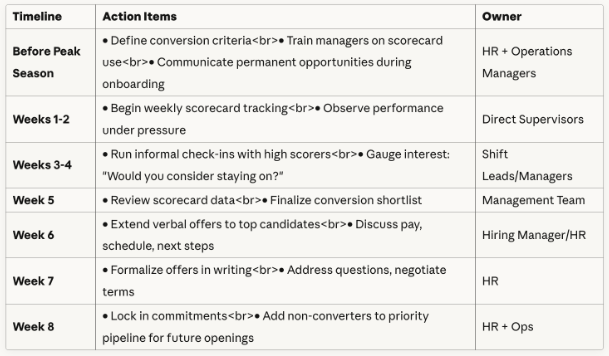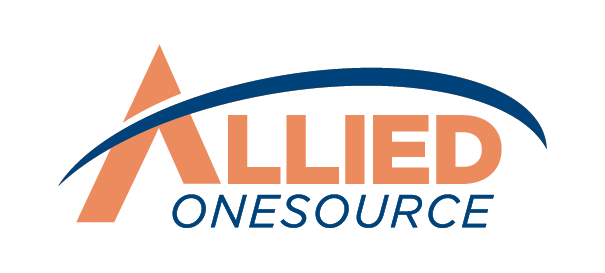Holiday Hiring Heroes: How to Find and Keep Seasonal Talent Who Show Long-Term Potential
Every peak season follows the same script: hire dozens of seasonal workers in October, train them through November, lean on them through December, then let them go in January. By September, you're back at it; writing job posts, scheduling interviews, onboarding a new batch who don't know your systems or your team.
The cycle never ends, and every year it costs more time and money to recreate what you just spent three months building. Holiday hiring doesn't have to be a recurring reset. When you treat Q4 staffing as a talent pipeline instead of a temporary fix, you can identify high performers during the season and convert them to permanent roles before they move on.
That shift requires a system for evaluating quickly, deciding early, and making offers while workers are still engaged, not after they've already accepted another job.
The Seasonal-to-Permanent Conversion Playbook
Most companies wait until the season ends to think about retention but by then, your best workers are gone. This walks you through the entire hiring cycle, from setting expectations before peak season starts to locking in commitments before contracts expire.
Before Peak Season Starts: Set Your Criteria and Prep Your Team
Define what "conversion-worthy" looks like before the chaos hits. If you wait until Week 6 to figure out what matters, you'll make inconsistent decisions based on whoever was memorable that day. Decide now: Are you prioritizing safety compliance? Adaptability when priorities shift? Ability to work independently?
The stakes are real. As of April 2025, 313,000 durable goods manufacturing job openings remain unfilled.¹ You're trying to fill permanent roles while qualified workers are walking out the door every January. Seasonal hiring gives you a live audition process to identify who can fill those gaps.
Train your managers on what to track and how to use the scorecard you'll introduce in Week 1. Then communicate the opportunity to seasonal workers during onboarding: "We hire permanent staff from our seasonal pool." That single sentence changes how workers approach the job and signals that strong performance leads somewhere.
Weeks 1-2: Deploy Your Evaluation Scorecard
Start tracking performance immediately. Waiting until Week 6 means you've already forgotten who handled the system crash in Week 2 or who stayed calm when half the team called out.
Keep it simple: managers spend five minutes each week scoring workers, not writing performance essays. You're looking for patterns across multiple weeks, not one heroic moment. By Week 4, you should already know who's on your conversion shortlist based on consistent scores, not gut feelings or whoever had a great last shift.
Weeks 3-4: Surface Interest Early and Watch Performance Under Pressure
Don't wait until the end of the season to find out who wants to stay. Around Week 3, let high-scoring workers know directly: "We're looking to bring on permanent staff after the holidays. If you're interested, let us know." Keep it straightforward; you're gauging interest, not making promises yet.
These weeks also tend to be when operations get messy. Shipping delays, system glitches, unexpected absences, chaos reveals who can handle the job long-term. Pay attention to who adapts without needing constant direction, who helps newer workers through problems, and who stays productive when things go sideways.
High-pressure moments tell you more about someone's fit than their performance during smooth operations.
Weeks 5-6: Make Your Shortlist and Extend Offers Early
Review your scorecard data and finalize who's getting conversion offers. Don't overthink this; if someone consistently scored 14+ points and expressed interest in Week 3-4, they're ready for an offer.
Extend verbal offers in Week 6 and get formal paperwork ready by Week 7. Early timing matters because your best performers will have multiple job opportunities by January. Employment in retail trade industries that hire seasonal employees increased by 494,000 from October to December 2023, and post-holiday layoffs were smaller than the initial buildup.²
Some companies are already retaining seasonal workers, the difference is whether you're doing it intentionally or scrambling at the last minute.
What makes offers stick? Competitive pay that doesn't feel like a downgrade after holiday premiums end, a clear path for growth beyond the entry role, and flexibility in scheduling where your operation allows it.
Weeks 7-8: Lock in Commitments or Build Your Pipeline
Finalize who's converting to permanent staff and get signed commitments before the season ends. For strong performers who can't commit to full-time work right now, add them to a priority pipeline for future openings.
Stay connected with these workers through quarterly check-ins when new positions open up, and offer referral bonuses when they recommend other quality candidates. The goal is simple: never start your next peak season from scratch again.
Your Seasonal-to-Permanent Conversion Toolkit
Use these tools together to identify and convert high performers before they accept offers elsewhere.
Weekly Performance Scorecard: Track Who's Worth Keeping
You can't retain talent you haven't been tracking. Use this scorecard weekly, not at the end of the season when it's too late.

Scoring Guide:
- 14-18 points = Strong conversion candidate (move to shortlist)
- 10-13 points = Solid performer (monitor, consider for pipeline)
- Below 10 points = Not recommended for permanent placement
8-Week Conversion Roadmap: When to Act on What
Timing determines whether you keep your best workers or lose them to competitors. This roadmap ensures you're making decisions during the season, not after everyone's already gone.

Critical Point: If you wait until Week 8 to start this process, your best performers have already accepted other jobs.
Stop Rebuilding Your Workforce Every Peak Season
Holiday hiring becomes a talent pipeline when you have a system for identifying high performers, evaluating them consistently, and making offers before they move on. Allied OneSource helps companies implement these conversion processes at scale; tracking performance during peak periods, maintaining talent pipelines, and reducing recruitment costs year after year.
We help you build a staffing strategy that doesn't reset to zero every January. Ready to keep your best seasonal workers year-round? Contact us today.
Reference
1., 2. The Interview Guys. “The Seasonal Hiring Patterns Analysis Report: Best and Worst Times to Job Search Across 20+ Industries with Success Rate Data.” The Interview Guys, 11 Aug. 2025, https://blog.theinterviewguys.com/the-seasonal-hiring-patterns-analysis-report/.











